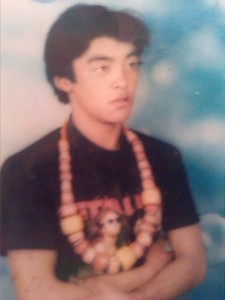
Kunchok Tseten set fire to himself on December 3, in Ngaba. His wife and some relatives have disappeared and are believed to have been taken into custody.
Update, December 5, 2013
According to information received from Tibetans in exile, Kunchok Tseten died soon after his self-immolation. His body has not been returned to his family. According to new information from the same sources, Kunchok Tseten had participated in a protest in Lhasa during the wave of unrest across Tibet in 2008, and was sent back to his home area of Machu by the authorities at that time.
A Tibetan father of two called Kunchok Tseten set fire to himself yesterday (December 3) in Meruma township in Ngaba, sparking protests as local people tried to stop police taking him away after he collapsed in the road in flames. Kunchok Tseten’s wife and some relatives have disappeared and are believed to have been taken into custody, according to Tibetan exile sources.
Kunchok Tseten was heard shouting loudly as he ran down the road ablaze, calling for the long life of the Dalai Lama, for His Holiness to return to Tibet and for Tibetans to be reunited both inside Tibet and in exile. A Tibetan with contacts in the area told Radio Free Asia: “Even after he collapsed on the ground, he was seen by local witnesses folding his hands together in prayer and uttering some words that were not audible.” (See RFA report: Tibetan Father of Two Self-Immolates in Ngaba).
Armed forces arrived on the scene quickly and attempted to take away Kunchok Tseten as he was still burning, according to exile Tibetan sources. It is not clear if he is still alive. But local people gathered and attempted to prevent him from being taken away. According to some sources, the standoff lasted as long as up to an hour.
A security clampdown has been imposed in Meruma, Ngaba (Chinese: Aba) Tibetan and Qiang Autonomous Prefecture, Sichuan. Shops and restaurants are now closed and some people’s mobile phones confiscated in an attempt to prevent news of the self-immolation spreading. Many Tibetans have been sentenced to long prison terms, including suspended death sentences, as part of a hard line and more systematic response by the authorities to recast the self-immolations as criminal acts and attribute blame for the self-immolations to outside forces. (See ICT reports: Distress at death sentence for Tibetan accused of ‘inciting ‘self-immolation’ and Six Tibetans in Gansu sentenced after protecting body of self-immolator in aggressive drive to criminalize self-immolations).
Kunchok Tseten and his wife have two sons who are under ten years old. Kunchok Tseten, who was from a nomad family in Machu (Chinese: Maqu) in Gansu, attended primary school. According to some exile sources, he participated in peaceful protests in Ngaba in 2012.
It is the 124th self-immolation by a Tibetan in Tibet and China (See ICT: Self-immolations by Tibetans). The last Tibetan to self-immolate, 20-year old monk Tsering Gyal, also called for Tibetans both inside and outside Tibet to be reunited while he was burning. According to a Tibetan source, when he was on his way to hospital after his self-immolation on November 11, “Tsering Gyal said that his self immolation is for the unity of Tibetans inside and outside Tibet. He said that he hoped Tibetans will stand together, facing both difficulties and happiness. He also said that he hoped Tibetans would protect and preserve their language and cultural identity, and said that these were his final expectations and hopes.” An eyewitness told a Tibetan in exile: “The man self immolated nearby a statue in the center of the county town and ran towards a government building. The person fell down to the ground after 10-12 yards. It was very clear that he was shouting ‘His Holiness the Dalai Lama’ more than 10 times.” (See ICT report: Tibetans gather at monastery in Golok after self-immolation of young monk).

